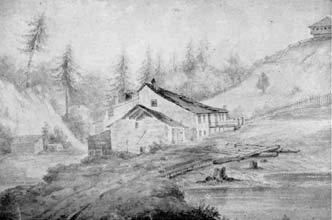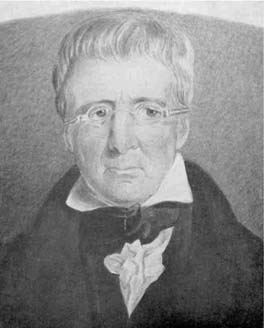
Bulletin 1 (I:1) May 1963
Home
Français
Introduction
History
Annual Index
Author & Subject
Credits
Contact


Provincial Exhibitions
Ontario Painters 1846-1867
by J. Russell Harper, Curator of Canadian Art
Pages 1 | 2 | 3 | 4 | 5 | 6 | 7
Mid-19th century standards of merit and excellence in painting differed from those prevailing in the present generation; art fashions change and the prize lists chronicle the tastes of the time. Victorian attitudes towards "historical" painting is a case in point. There was still a hang-over in the 1880s of the vogue for soul-stirring romantic painting which was climaxed by Delacroix's "Liberty on the Barricades". "Historical" painting had also a patriotic propagandistic value, first conceived in such canvases as Benjamin West's "Death of Wolfe", Trumbull's "The Surrender of Cornwallis at Yorkton", and ever-present in Imperial Napoleonic art; these paintings were familiar to people of Upper Canada from prints. Possibly the earliest Canadian historical painter was William von Moll Berczy; he was working shortly after 1800, but used little or no Canadian subject-matter. Precedence was given to "Historical Painting" in the early Agricultural Society exhibitions. Judges refused Paul Kane the 1852 prize in this class; he had entered paintings of "contemporary Indian life and manners". (16) The judges explained that they were not properly historical, noting that
it was clearly a misapprehension of the nature of the subject matter required, and not a want of power, which occasioned this disappointment - we shall hope to see, upon a future occasion, that the spirit stirring incidents of the last war, and the great events which had marked the social progress and constitutional history of the country, have found their fitting expositor in the first native artist of Canada. Considering, however, that historical painting is the highest branch of art, we must remark that the prizes offered are wholly insufficient to tempt an artist capable of executing such a subject to sacrifice time which might be given to easier and more remunerative employment.
Nevertheless the only so-called historical painting awards up to and including 1859 were to Kane, presumably the Indian series stemming from his 1845-6 tour of the west, though he completed a painting of "The Landing of Columbus". Thereafter historical painting prizes went to Alexander Davidson, a Hamilton portrait painter, Robert Whale, W. N. Cresswell, and R. Baigent. The classification was altered to "historical or general figure subject" in the year in which Baigent won the prize, 1866, and amended to "historical or genre" the next year; it indicates a trend in artistic taste away from strictly historical subject-matter although still known in the works of the 20th century C. W. Jeffreys and others.
Portrait and miniature painting was popular in Canada from the late 18th century. Non-Canadian itinerant workers catered to the trade, but a few established artists, particularly in Quebec, Montreal, and Halifax did much work in their own communities, as well as travelling to other centres. Painted portraits adorned the home as did photographs in a later era. Detailed reviews describe portraits at the provincial exhibitions. That of 1851 mentions: (17)
A fine portrait of a lady and child in coloured crayon drawing, by Miss Morris of Brockville, which was worthy of the first prize it received, a collection of various portraits by Miss Janes of this town, but which we thought too highly coloured, but well executed in other respects - a collection of valuable and beautiful portraits &c by Mr Hoppner Meyer, which denotes no mean artist.
Quality in 1852 was brought into serious question with this statement: (18)
Portrait painting was very abundantly but very indifferently represented. It by no means follows that a young artist who can catch a tolerable likeness, and has overcome the first difficulties of the brush, can deal with a full-sized portrait. Forgetfullness of this fact produced some sad examples of vaulting ambition which o'erleaps itself. The portraits were too large, and their defects were more glaring than their merits. A pleasing likeness by Mr George Reid, and a portrait in full profile by Mr Griffith, of much expression, although the colouring and especially the background, were far from pleasing, were, with the two Indian portraits (by Paul Kane), which gained the first and second prizes, the only exceptions we remarked.
The prize list specifies three portrait classifications - water colour, oil, and crayon. The first is now an almost unknown art. Of eight pre-Confederation water colour prize winners Hoppner Meyer was perhaps the best, and his works have been described before in some detail. (19) J. B. Wandesford was a painter with no great depth of perception but his works have considerable naive charm. Sixteen painters in oil received prizes in the same period. Robert Whale was a consistent winner, while William Sawyer and J. C. Forbes later made considerable names for themselves. Meyer, D. Fowler, and J. W. Bridgman were the best known of five crayon portrait winners. The above deals only with professional exhibitors; there were numerous amateurs.
Improvements in photography, first developed in 1839, were undoubtedly the major factors in portrait painting deterioration during the 19th century. The decline in quality was most rapid during the years here reviewed. Portraiture, while threatened, suffered scarcely at all during the first decade after the invention of photography. Slight inroads began in the early 1850s although the silver daguerreotype was still the dominant form, and no match for the more attractive coloured painted portrait or miniature. Daguerreotypes first were admitted in the 1850 provincial exhibition, and were the only types of photographs shown until 1854; E. J. Palmer of Toronto won all of the prizes. The real blow came when ambrotypes, which were capable of being coloured, appeared in 1858; Cresswell and Palmer were ambrotype prize winners. Exhibitions of actual coloured photographs began in 1861. Next year, prizes were awarded to photographs under the heading: coloured portraits, portraits finished in oil, plain portraits, and landscapes. A separate photographic section was introduced in 1863, the prize list including photographs finished in ink, chalk, and a host of other variations. These were easy to produce and cheap. Ontario's portrait painters lost heart, as did others in the western world. Their work soon lacked conviction, and many less sensitive men, J. W. Bridgman being an example, seeing the universal preference for the new medium, simply adopted a style which imitated the coloured photograph. Some proficient painters became professional tinters, and even F. A. Verner after an adventurous sojourn studying in England and on the continent, won the 1866 prize for photo finishing in oil. A few artists were so proficient that their tinted works even now are mistaken occasionally for original paintings.
An eloquent commentary on the fate of the painted portrait shows that at least some Canadians were aware of the rapid deterioration. This was published as an 1865 editorial comment in Le Journal de Québec. (20) While specifically referring to one artist, J. B. Wilkinson, the general comments are applicable to the broader Canadian scene. The editorial reads:
We wish to draw the reader's attention to the announcement of Mr J. B. Wilkinson, portrait-painter, who has been living for some time among us. We have seen his canvases and we can say that he is both a clever and a conscientious painter.
Since the appearance of photography, oil painting has been, so to speak, in its "widowhood", and if one thinks about it, scarcely exists. Moreover many of the artists, in order to live, have been obliged to make themselves into photographic machines, that is to say, to lend the weight of their palette to the new process, clothing in colour that which has no life. In this ungrateful work, they lose all inspiration and all originality.
Fashion is a strange thing, often forcing men to pay more for a badly painted photograph than a good original painting. Now a photograph of the face, one must have the graciousness to say it, is not nature; it is not life with its infinite movements; it is not the truthful and reflective soul; it is simply a machine-forced immutability of a moment, with a mechanical stiffness and rigidity. Also there are faces which the photograph is powerless to portray, and which the clever painter alone can see.
We are aware also of the unfortunate pitfalls in which the photograph finds itself, particularly those of large dimensions, where larger proportions are given to objects or parts of objects which are nearer the camera, and which disfigure particularly the nose and hands.
Encourage then the painter, above all when you want large portraits, since you will get something better for the same price and for even less. Mr Wilkinson awaits you; he is excessively moderate in his prices.
And what was the final effect of photograph on painting? Miniatures and the small related water colour portrait virtually disappeared; their demand for use in the home approximates that of photographs. Larger oil portraits survived, but chiefly for prestige purposes. Only the occasional rugged and sensitive Canadian artist continued to paint solely for portrayal of aesthetic qualities and the sitter's inner character, the real heart of true portrait painting.
No stigma was attached in mid-19th century to exhibition of copies. This was an accepted, legitimate and quite honourable practice. Antoine Plamondon, first vice-president of the Royal Canadian Academy, painted both variations on Raphael Madonnas, and portraits from photographs. Antoine Sebastien Falardeau, the French Canadian farm boy who went to Italy as an art student, built his celebrated Florentine fame solely as a copyist of Renaissance and Baroque canvases. Some early provincial prize lists specify paintings from life, but an 1866 innovation was a whole new professional section for copies in oil and water colour. Some well known people, Mower Martin, Bridgman, Baigent and Mrs Fitzgibbon who was a flower painter and niece of Mrs Traill, received awards in this class. The professional copyist section was discontinued the next year, but a similar amateur class was retained for several exhibitions.
Next Page | Part III
1 | 2 | 3 | 4 | 5 | 6 | 7
Top of this page
Annual Index | Author & Subject | Credits | Contact
This digital collection was produced under contract to Canada's Digital Collections program, Industry Canada.
"Digital Collections Program, Copyright © National Gallery of Canada 2001"